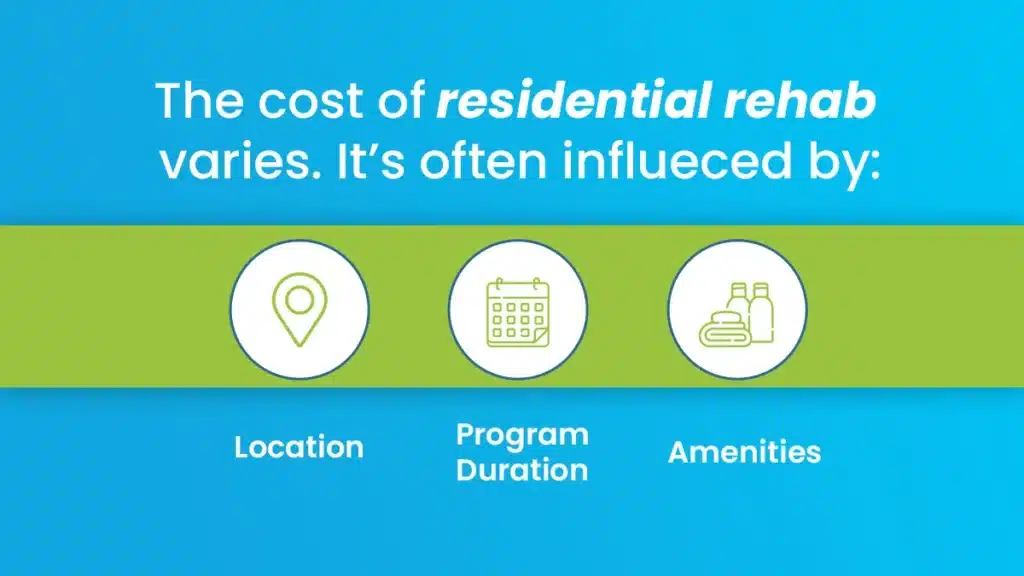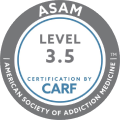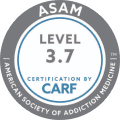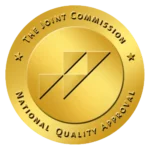Residential rehabilitation is a step towards overcoming substance abuse, offering a structured environment for recovery. However, this journey prompts a common question: “How much does residential rehab cost?”
The cost of residential rehab varies widely depending on location, amenities, duration of stay, and the level of care provided. Understanding the financial aspect is necessary for individuals and families considering rehab options, ensuring they can access the necessary support without undue financial strain.
Key Takeaways
Rehab includes different therapies, medical treatments, and support systems to help individuals overcome dependencies. Here is what the article entails:
- Residential rehab costs vary widely depending on location, amenities, and duration of stay.
- Quality of care and personalized treatment plans significantly impact the overall cost of residential rehab.
- Insurance coverage and financial assistance options may help mitigate the expense of residential rehab programs.
For comprehensive addiction treatment, contact The Haven Detox-South Florida at (561) 328 – 8627 to get more information.

Factors Influencing The Cost Of Residential Rehab
Residential rehab costs vary based on several factors. Understanding these factors can help you make informed decisions when seeking treatment.
Type Of Facility
The type of rehab facility significantly impacts the cost. Luxury rehab centers, which offer high-end amenities and private accommodations, tend to be more expensive. Standard facilities provide essential services and shared rooms at a lower cost. Specialized facilities that focus on treating specific addictions or dual diagnoses charge more due to their specialized care and resources.
Geographic Location
The location of the rehab center plays a big role in the cost of comprehensive treatment. Facilities in urban areas or popular destinations usually have higher costs due to the cost of living in those areas. Conversely, rural or less popular locations might offer more affordable options. For example, a rehab center or a treatment facility in Malibu, California, will likely cost more than one in a small town in the Midwest.
Length Of Stay
How long you stay in the residential program is crucial to the overall cost. Longer stays naturally incur higher expenses. Short-term programs, such as 30-day treatments, cost less than extended programs lasting 60, 90 days, or more. The appropriate length of stay depends on the individual’s needs and the severity of their drug addiction.
Type Of Treatment Programs
Different treatment programs have varying costs. Standard treatment programs typically include detox, therapy, and counseling, which are relatively affordable. Specialized treatments, such as dual diagnosis care, holistic therapies, prevention programs, intensive care, or medically assisted treatments, can increase the price. The complexity and comprehensiveness of the program influence the overall cost.
Staff Expertise And Credentials
The qualifications and expertise of the addiction center staff also impact costs. Facilities with highly trained, experienced, certified professionals tend to charge more. These experts can include doctors, psychologists, therapists, and addiction specialists. The quality of care these professionals provide often justifies the higher price, which can lead to better treatment outcomes.
Amenities Offered
Amenities offered by the facility play a significant role in determining the cost. Luxury rehabs for substance use disorder may provide private rooms, gourmet meals, spa services, fitness centers, and recreational activities, driving up the cost. Standard facilities focus on essential services, making them more affordable. The level of comfort and additional features you desire will affect the overall expense.
Average Cost Of Residential Rehab
Residential rehab costs vary widely depending on several factors, including location, type of facility, and the services provided. On average, the price can range from $5,000 to $30,000 for a 30-day program. Luxury rehab centers, which offer high-end amenities and personalized care, can cost even more, sometimes exceeding $100,000 monthly.
Insurance coverage can help reduce these costs, but out-of-pocket expenses are still common. Understanding what each rehab program offers and how it fits within your budget is essential.
Short-Term Rehab Costs
Short-term rehab typically lasts between 28 to 30 days. The cost for these alcohol abuse programs can vary but usually falls between $5,000 and $20,000. Basic programs might be at the lower end of the spectrum, while more comprehensive ones with additional therapies and amenities will be at the higher end.
Short-term rehab is often more affordable than long-term options, making it accessible for many people seeking immediate help. Insurance policies may cover part of the expenses, but it’s important to check with your provider about what’s included.
Long-Term Rehab Costs
Long-term rehab usually lasts between 60 to 90 days or even longer. These programs provide more extensive treatment and are designed for individuals needing more recovery time. The cost for long-term rehab can range from $20,000 to $60,000 or more. Despite the higher price, many find the extended care beneficial for achieving lasting sobriety.
Long-term rehab includes more in-depth therapy, life skills training, and ongoing support, contributing to the higher cost. Insurance can help offset these expenses, but out-of-pocket costs can still be significant. It’s crucial to weigh the benefits of longer treatment against the financial commitment required.
Comparison Of Different Types Of Rehab Facilities
Rehabilitation facilities offer various programs and services tailored to help individuals recover from substance abuse, physical injuries, mental health issues, and other conditions requiring intensive support.
Luxury Vs. Standard Facilities
Luxury rehab facilities offer high-end amenities like private rooms, gourmet meals, and spa treatments. They often provide holistic therapies such as yoga and acupuncture. These facilities aim to create a comfortable and stress-free environment.
In contrast, standard drug rehab centers focus more on essential treatment services. They provide basic accommodations, group therapy sessions, and standard medical care. While they lack the lavish perks of luxury rehabs, standard facilities still offer effective treatment programs. The choice between luxury and standard often depends on personal preference and financial capability.
Non-profit Vs. Private Facilities
Non-profit rehab facilities operate on funding from donations, grants, and government aid. Their primary goal is to provide affordable care to those in need. These facilities often have sliding-scale fees based on the patient’s ability to pay. Due to high demand and limited funding, non-profit rehabs may need more resources and longer waiting lists.
On the other hand, private rehab facilities are run as businesses and usually offer more immediate access to treatment. They can afford to invest in more advanced therapies and better amenities, but their services typically come at a higher cost. The decision between nonprofit and private facilities often hinges on budget and access to immediate care.
Inpatient Vs. Outpatient Rehab
Inpatient rehab requires patients to stay at the facility for their treatment. This setting provides a structured environment, round-the-clock care, and a focus on intensive therapy. Patients benefit from being removed from triggers and having constant support. Outpatient rehab allows patients to live at home while attending treatment sessions.
This option is more flexible, letting individuals maintain work and family responsibilities. However, it also means they must have a strong support system at home to avoid relapse. The choice between inpatient and outpatient rehab depends on the severity of the medical condition and personal circumstances.
Financial Assistance And Insurance
Paying for health care can be tough, but there are many ways to get help. Financial assistance and insurance options can make medical costs more manageable.
Health Insurance Coverage
Health insurance is a key way to cover medical expenses. It helps pay for doctor visits, hospital stays, and prescription medicines. Many people get health insurance through their jobs. Others may buy it on their own. Government programs like Medicaid and Medicare also offer coverage for those who qualify. Having health insurance means you pay less out of pocket for your care.
Health Insurance Coverage
Health insurance is a key way to cover medical expenses. It helps pay for doctor visits, hospital stays, and prescription medicines. Many people get health insurance through their jobs. Others may buy it on their own. Government programs like Medicaid and Medicare also offer coverage for those who qualify. Having health insurance means you pay less out of pocket for your care.
Scholarships And Grants
Scholarships and grants provide free money to help pay for education and sometimes healthcare. Many schools, organizations, and governments offer scholarships based on need or merit. Grants, like scholarships, can be paid.
The government or non-profit organizations often give them. Some grants specifically help with medical bills for inpatient and outpatient services. Applying for scholarships and grants can greatly reduce your financial burden.
Payment Plans And Sliding Scale Fees
Many health or insurance providers offer payment plans if you do not have insurance or need extra help. Payment plans let you pay your bills over time in smaller amounts. Some clinics and hospitals also use sliding scale fees. This means they charge you based on how much money you make. If you make less, you pay less. Sliding scale fees ensure everyone can afford the addiction recovery services and care they need.
Benefits Vs. Costs
When considering any investment, weighing the benefits against the costs is important. The initial expense might seem high, but the long-term advantages often outweigh these costs. Let’s explore the short-term financial impact, long-term savings, and health benefits.
Short-Term Financial Impact
In the short term, investing in health and wellness can appear costly. These expenses add up quickly, whether it’s spending on healthier food, gym memberships, or wellness programs. For instance, organic foods often cost more than processed alternatives, and fitness classes by medical professionals or personal trainers require upfront payments.
However, these initial costs are an investment in a healthier future. While you might see an immediate hit to your wallet, the benefits start to show as you stick with healthier habits. Healthier employees tend to take fewer sick days, which can also reduce business costs.
Long-Term Savings And Health Benefits
Over time, the savings and health benefits become more apparent. A healthier lifestyle can significantly reduce medical bills. Regular exercise and a balanced diet can help prevent chronic diseases such as diabetes, heart disease, and obesity.
This means fewer doctor visits, less medication, and fewer hospital stays. In the long run, investing in health and wellness pays off. Besides financial savings, improved health leads to a better quality of life. People who exercise regularly and eat well often feel more energetic and less stressed. They can enjoy activities they love without health-related limitations. This investment not only saves money but also enhances overall well-being and happiness.
Frequently Asked Questions (FAQ)
Factors influencing residential rehab costs include the type of program (outpatient or residential), level of medical supervision, the inclusion of mental health services, whether it’s inpatient or outpatient treatment, drug use severity, available, affordable options, alternative therapies, insurance coverage, facility amenities, staff expertise, treatment duration, and individual needs.
In addition, expenses may arise for medical detox, specialized treatment for co-occurring mental health disorders or medical conditions, and family involvement. Costs vary among treatment centers, often requiring professional medical advice to navigate payment options and insurance policies effectively.
Insurance plans may cover residential rehab for substance abuse disorders, addiction treatment, and alcohol rehab. Coverage may include outpatient programs, inpatient treatment, and mental health services. Rehab costs, including residential care, vary based on treatment options like partial hospitalization programs and the individual’s unique needs.
Some insurance companies may provide coverage for drug rehab, but it’s essential to check with the insurance company and treatment provider. Rehabilitation centers often have medical experts to provide additional support, and National Institutes may offer resources for substance abuse treatment.
Experience Renewal With The Haven Detox-South Florida
At The Haven Detox-South Florida, we understand the challenges of addiction and are committed to providing a safe, supportive environment where you can heal and thrive.
Our premier facility offers comprehensive detox and residential treatment programs designed to support your journey to recovery. Our skilled therapists utilize evidence-based therapies and personalized counseling to address the root causes of addiction and support long-term recovery.Don’t wait to experience healing. Contact us at (561) 328-8627 to learn how to start your journey to a sober, fulfilling life.







